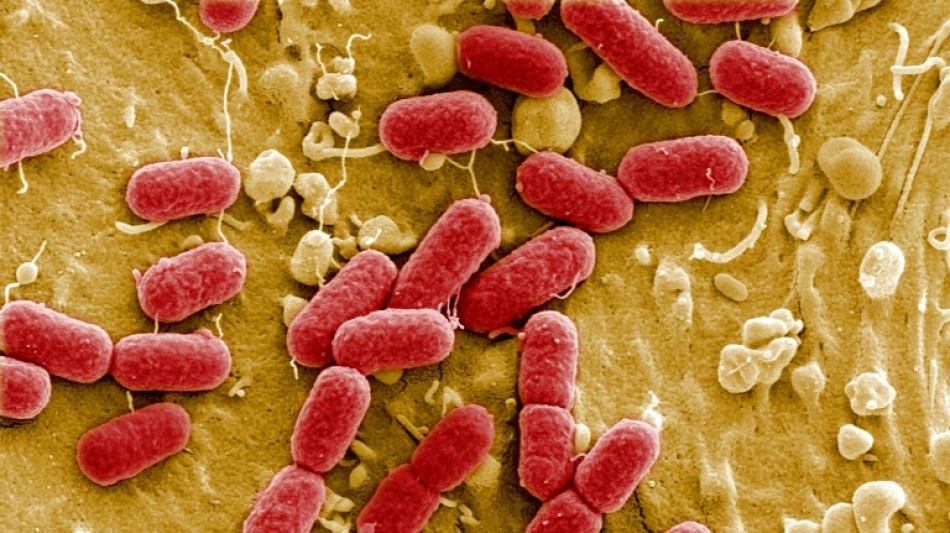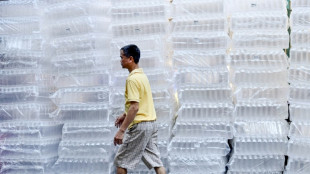
-
 American McNealy takes first PGA title with closing birdie
American McNealy takes first PGA title with closing birdie
-
Sampaoli beaten on Rennes debut as angry fans disrupt Nantes loss

-
 Chiefs edge Panthers, Lions rip Colts as Dallas stuns Washington
Chiefs edge Panthers, Lions rip Colts as Dallas stuns Washington
-
Uruguayans vote in tight race for president

-
 Thailand's Jeeno wins LPGA Tour Championship
Thailand's Jeeno wins LPGA Tour Championship
-
'Crucial week': make-or-break plastic pollution treaty talks begin

-
 Israel, Hezbollah in heavy exchanges of fire despite EU ceasefire call
Israel, Hezbollah in heavy exchanges of fire despite EU ceasefire call
-
Amorim predicts Man Utd pain as he faces up to huge task

-
 Basel backs splashing the cash to host Eurovision
Basel backs splashing the cash to host Eurovision
-
Petrol industry embraces plastics while navigating energy shift

-
 Italy Davis Cup winner Sinner 'heartbroken' over doping accusations
Italy Davis Cup winner Sinner 'heartbroken' over doping accusations
-
Romania PM fends off far-right challenge in presidential first round

-
 Japan coach Jones abused by 'some clown' on Twickenham return
Japan coach Jones abused by 'some clown' on Twickenham return
-
Springbok Du Toit named World Player of the Year for second time

-
 Iran says will hold nuclear talks with France, Germany, UK on Friday
Iran says will hold nuclear talks with France, Germany, UK on Friday
-
Mbappe on target as Real Madrid cruise to Leganes win

-
 Sampaoli beaten on Rennes debut as fans disrupt Nantes loss
Sampaoli beaten on Rennes debut as fans disrupt Nantes loss
-
Israel records 250 launches from Lebanon as Hezbollah targets Tel Aviv, south

-
 Australia coach Schmidt still positive about Lions after Scotland loss
Australia coach Schmidt still positive about Lions after Scotland loss
-
Man Utd 'confused' and 'afraid' as Ipswich hold Amorim to debut draw

-
 Sinner completes year to remember as Italy retain Davis Cup
Sinner completes year to remember as Italy retain Davis Cup
-
Climate finance's 'new era' shows new political realities

-
 Lukaku keeps Napoli top of Serie A with Roma winner
Lukaku keeps Napoli top of Serie A with Roma winner
-
Man Utd held by Ipswich in Amorim's first match in charge

-
 'Gladiator II', 'Wicked' battle for N. American box office honors
'Gladiator II', 'Wicked' battle for N. American box office honors
-
England thrash Japan 59-14 to snap five-match losing streak

-
 S.Africa's Breyten Breytenbach, writer and anti-apartheid activist
S.Africa's Breyten Breytenbach, writer and anti-apartheid activist
-
Concern as climate talks stalls on fossil fuels pledge

-
 Breyten Breytenbach, writer who challenged apartheid, dies at 85
Breyten Breytenbach, writer who challenged apartheid, dies at 85
-
Tuipulotu try helps Scotland end Australia's bid for Grand Slam

-
 Truce called after 82 killed in Pakistan sectarian clashes
Truce called after 82 killed in Pakistan sectarian clashes
-
Salah wants Liverpool to pile on misery for Man City after sinking Saints

-
 Berrettini takes Italy to brink of Davis Cup defence
Berrettini takes Italy to brink of Davis Cup defence
-
Lille condemn Sampaoli to defeat on Rennes debut

-
 Basel backs splashing the bucks to host Eurovision
Basel backs splashing the bucks to host Eurovision
-
Leicester sack manager Steve Cooper

-
 IPL auction records tumble as Pant, Iyer break $3 mn mark
IPL auction records tumble as Pant, Iyer break $3 mn mark
-
Salah sends Liverpool eight points clear after Southampton scare

-
 Key Trump pick calls for end to escalation in Ukraine
Key Trump pick calls for end to escalation in Ukraine
-
Tuipulotu try helps Scotland end Australia's bid for a Grand Slam

-
 Davis Cup organisers hit back at critics of Nadal retirement ceremony
Davis Cup organisers hit back at critics of Nadal retirement ceremony
-
Noel in a 'league of his own' as he wins Gurgl slalom

-
 A dip or deeper decline? Guardiola seeks response to Man City slump
A dip or deeper decline? Guardiola seeks response to Man City slump
-
Germany goes nuts for viral pistachio chocolate

-
 EU urges immediate halt to Israel-Hezbollah war
EU urges immediate halt to Israel-Hezbollah war
-
Far right targets breakthrough in Romania presidential vote

-
 Basel votes to stump up bucks to host Eurovision
Basel votes to stump up bucks to host Eurovision
-
Ukraine shows fragments of new Russian missile after 'Oreshnik' strike

-
 IPL auction records tumble as Pant and Iyer snapped up
IPL auction records tumble as Pant and Iyer snapped up
-
Six face trial in Paris for blackmailing Paul Pogba


Harmful pollution boosting superbug 'silent pandemic'
Containing and cleaning up environmental pollution, especially in waterways, is crucial to controlling increasingly bullet-proof superbugs which could kill tens of millions by mid-century, a new UN report said Tuesday.
Superbugs -- strains of bacteria resistant to antibiotics -- are estimated to have killed 1.27 million people in 2019, and the World Health Organization says antimicrobial resistance (AMR) is one of the top global health threats on the near-term horizon.
Up to 10 million deaths could occur every year by 2050 because of AMR, the UN says.
The disinfectants, antiseptics and antibiotics that can help microbes become stronger are everywhere, from toothpaste and shampoo to cow's milk and wastewater.
A new report Tuesday said pollution is a key driver in the "development, transmission and spread" of AMR, calling for urgent action to clean up the environment.
"With increasing pollution and lack of management of sources of pollution, combined with AMR in clinical and hospital settings and agriculture, risks are increasing," said the report from the UN Environment Programme.
Antimicrobial resistance is a natural phenomenon, but the overuse and misuse of antibiotics in humans, animals and plants has made the problem worse.
This means antibiotics may no longer work to fight the very infections they were designed to treat.
The UN report Tuesday said that pollution in the environment from key economic sectors has exacerbated the problem, namely from the pharmaceutical and chemical manufacturing sectors, along with agriculture and health care.
Herbicides to control weeds on farms may also increase AMR, while heavy metals are also contributing to the problem.
Once antimicrobials enter the environment they seep into the food chain -- they've been found in fish and cattle -- and loop back into factories making everyday toiletries, for example.
- 'Silent pandemic' -
Antimicrobial resistant genes are in waterways across the globe, from the Ganges River in India to the Cache la Poudre River in the US state of Colorado, the UN study found.
"This is a real issue, because rivers are often the source of our drinking water," Jonathan Cox, senior lecturer in microbiology at Britain's Aston University, told AFP.
"It's already the silent pandemic," warned Cox, who is not linked to the UN study. "It is becoming the next pandemic without us really recognising it."
Prevention is key, the UN said.
"Fuelled by population growth, urbanisation and growing demand for food and healthcare, we can expect an increase in the use of antimicrobials and in pollutant releases into the environment," it said.
The UN urged governments and international groups to address "key pollution sources", including sewage, city waste, healthcare delivery, pharmaceutical manufacturing and intensive crop sectors.
Cox said solutions need to be global, since AMR is so pervasive.
One answer is to focus on clinical approaches, such as improving rapid testing for infections so that antibiotics are not incorrectly prescribed.
Another is improving wastewater management to remove antimicrobials. But such processes are complicated and costly.
"The technology is out there, it just isn't being employed because governments don't care so much about the environment as they do about the bottom line," Cox said.
K.Thomson--BTB


